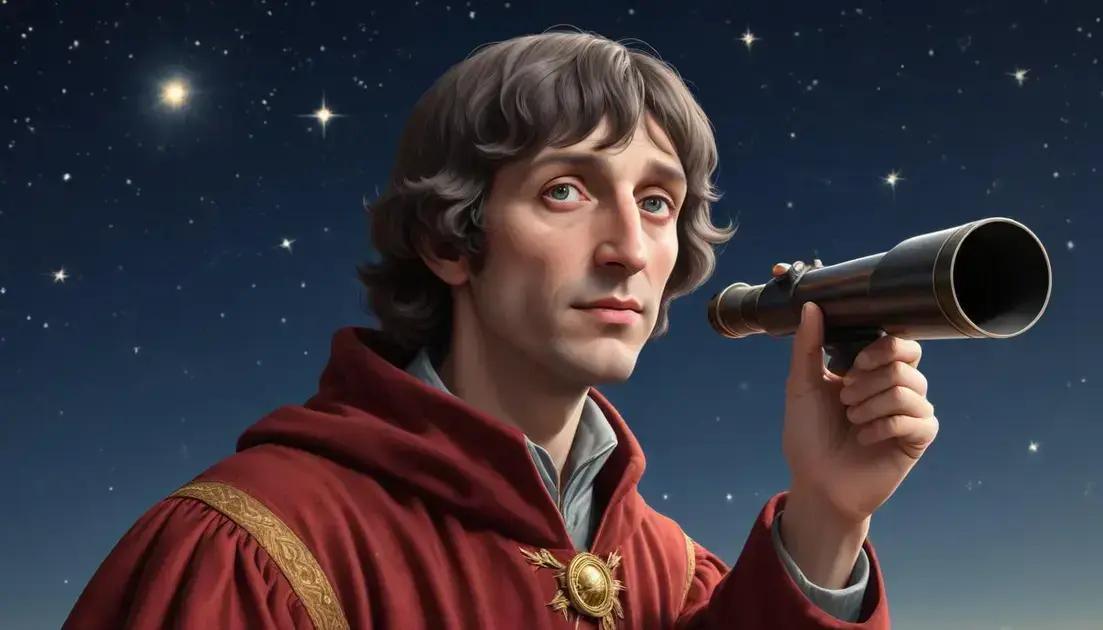
Copernicus and the Sun at Center: The Beginning of the Scientific Revolution
Nicolaus Copernicus revolutionized astronomy by proposing the heliocentric model, which places the sun at the center of the universe, challenging the long-held geocentric views. His ideas paved the way for future scientists like Galileo and Kepler, emphasizing observation and mathematical reasoning. This shift not only transformed our understanding of planetary motion but also initiated the Scientific Revolution, marking a significant legacy in the field of astronomy that continues to influence modern science.
Copernicus changed the game by moving the Sun to the center of our solar system. Ready to explore how this revolutionary idea sparked a scientific awakening?
The Challenge to Geocentrism
The idea of geocentrism held that Earth was the center of the universe. For many years, people believed this. It seemed obvious. The sun and stars moved around the Earth. But this view had its challenges.
Understanding Geocentrism
Geocentrism came from ancient thinkers like Aristotle and Ptolemy. They thought everything revolved around our planet. This belief shaped how people understood the cosmos for centuries.
The Copernican Revolution
Then came Copernicus. He proposed a bold idea: the sun was at the center, not Earth. This was a huge shift in thinking. It meant that the planets, including Earth, revolved around the sun.
Evidence Against Geocentrism
Over time, scientists gathered evidence against geocentrism. Observations of planets showed they didn’t always follow the paths expected in a geocentric model. This puzzled many.
Using telescopes, astronomers like Galileo provided proof that changed minds. He observed moons around Jupiter, showing that not everything orbited Earth.
The Impact of Copernicus’ Ideas
Copernicus’ ideas didn’t just change astronomy. They shook the foundation of science. People began to question old beliefs. This led to the Scientific Revolution, changing how we see the world.
With new tools and ideas, science began to grow. More discoveries followed, giving humanity a clearer view of the universe. The challenge to geocentrism sparked a quest for true knowledge.
Key Figures in the Scientific Revolution
During the Scientific Revolution, many key figures emerged. These thinkers changed our view of science and the universe. They laid the groundwork for modern science.
Nicolaus Copernicus
Copernicus was a Polish mathematician and astronomer. He introduced the heliocentric model. This theory placed the sun at the center of the universe. His ideas challenged the long-held belief that Earth was the center.
Galileo Galilei
Galileo was an Italian scientist. He improved the telescope and made important discoveries. He spotted moons orbiting Jupiter. This showed that not everything revolved around Earth. His work supported Copernicus’ theories.
Johannes Kepler
Kepler was a German astronomer. He developed laws of planetary motion. His work helped explain how planets traveled around the sun. Kepler’s insights were vital for future space exploration.
Isaac Newton
Newton made groundbreaking contributions to physics and mathematics. He formulated the laws of motion and universal gravitation. His work provided a framework for understanding natural phenomena.
Impact of These Thinkers
These key figures transformed how we understand the world. They encouraged people to rely on observation and reason. Their influence continues to shape scientific thought and discovery today.
Impact on Astronomy
The Scientific Revolution had a huge impact on astronomy. It changed how people viewed the stars and planets. Before this, many believed in the geocentric model.
Shifting Perspectives
With Copernicus’ heliocentric theory, everyone had to rethink their beliefs. Suddenly, Earth was not the center of the universe. This was a big deal for many.
Advancements in Tools
New tools, like the telescope, improved our ability to observe space. Galileo’s improvements allowed clear views of celestial bodies. He saw Jupiter’s moons, changing our understanding of the solar system.
The Role of Mathematics
Mathematics became vital in astronomy during this time. Kepler’s laws of planetary motion explained how planets moved. This brought precision to star charts and navigation.
A New Era of Exploration
These changes opened doors for more discoveries. Astronomers began to explore the universe further. Ideas about gravity and light emerged, promoting deeper questions about space.
Long-lasting Effects
The impact on astronomy is felt even today. The methods and discoveries of that time laid the foundation for modern space science. We owe a lot to the Revolutionary thinkers who changed our view of the cosmos.
Legacy of Copernicus
The legacy of Copernicus is vast and significant. His ideas changed how we understand the universe. By placing the sun at the center, he shifted the focus from Earth.
Challenge to Old Beliefs
Copernicus challenged centuries of thought. The geocentric model had been dominant for over a thousand years. His work made people think differently about their place in the cosmos.
Inspiration for Future Thinkers
Copernicus inspired many future scientists. His ideas laid the groundwork for astronomers like Galileo and Kepler. They built upon his theories to develop their own groundbreaking work.
A New Scientific Approach
His methods emphasized observation and mathematics. This approach became essential for science. It encouraged thinkers to rely on evidence and inquiry, sparking the Scientific Revolution.
Influence on Modern Astronomy
Today, we still feel Copernicus’s impact. His heliocentric model is a staple in astronomy education. It shapes our understanding of planetary motion and the solar system.
Revolutionary Ideas
Copernicus’s courage to propose new ideas was revolutionary. He paved the way for scientific progress. His legacy reminds us of the importance of questioning established beliefs.
Conclusion
In conclusion, Nicolaus Copernicus changed the way we see the universe with his bold ideas. By placing the sun at the center, he challenged years of old beliefs. His work inspired future scientists like Galileo and Kepler to explore further.
Copernicus’s legacy continues in modern astronomy. His emphasis on observation and questioning established views set the stage for the Scientific Revolution. Today, we still study his heliocentric model to understand how planets move.
Ultimately, Copernicus teaches us the value of curiosity and the power of new ideas. His contributions remind us to always seek knowledge and question what we think we know.


